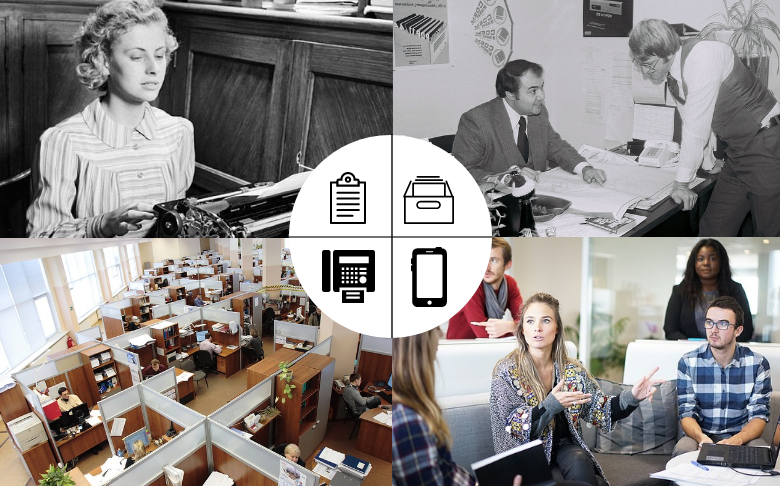See how our workplace expectations have changed since 1946

What motivates you at the office? How do you approach meetings and group work? Do you challenge authority or look up to them? All of your answers are probably quite different than other generations in the workforce, and unlocking the answers for each generation you deal with can be a solved mystery that will make you more effective in business.
Think how your first boss would have answered those questions. It’s probably quite different. What about that new up-and-comer entering the office this year? They will have an entirely transformed approach.
Unlocking the mysteries: How other generations think
Workplace expectations in business are very different than they were even 20 years ago, and they have hugely changed from those of 50 years past. Six key factors have all contributed to a massive upheaval of what leaders and employees feel they have a right to expect in their work life:
- The Rise of Woman Power
- Right-brain/Left Brain Thinking
- Education
- Technology
- Confidence
- Values
When considered individually, each of these factors have played a role in changing conditions within the business workplace. Together, they have created the perfect environment for the rights and expectations of individuals to become as important as the vision of the leaders and where employers need to keep their staff happy in order to keep them at all.
Taken from Confident Leadership in 21st Century Business: Bridging the Generation Gaps, the following chart offers a comparison of changing workplace expectations in business since 1946. Notice how each generation has their own shift in the way they approach the business world.
| Category | Boomers I | Boomers II | Gen X | Gen Y | Gen Z |
| Birth Year | 1946-1954 | 1955-1965 | 1963-1980 | 1980-2000 | 1995- |
| Coming of Age | 1967-1975 | 1976-1986 | 1984-2001 | 2001-2021 | 2008- |
| Meeting Style | Value meetings and opportunities to brainstorm. | Value the invitation to participate, and eager to show themselves capable. | Like meetings with a purpose. Don’t like to waste time. Prefer independent time. | Prefer short, casual meetings with team activities. Want to be entertained. | Eager to participate. Little patience for repetition or delays. |
| Attitude
Toward Authority |
Honor, respect | Disillusioned and untrusting | Skeptical, suspicious | Need to be respected by leaders | Need to be valued by leaders |
| Technology | Master it | Improve it | Enjoy it | Employ it | Adapt it |
| Interactive Style | Self-absorbed | Self-sufficient | Self-starting free agents | Team player | Collaborative |
| Work is… | An exciting adventure | An arduous adventure | A necessary challenge | Meant to be meaningful | A means to a better world |
| Characteristics | Driven, optimistic, competitive, think people should pay their dues | The “in-it-for-me” group, struggling to compete with Boomers I | Latch-key kids, survivors, skeptical, self-reliant | Ask why, prefers teamwork and supportive structure, craves feedback and instant gratification | Analytical information processors, world-wide collaborators, ready to tackle global issues |
| Message that Motivates | You are important to success | You matter | We need your ideas | You and your co-workers can turn this place around | The world needs you |
One career for life? Not anymore.
Choosing a career for life is no longer the norm. Today, multiple and highly divergent careers are increasingly common.
As little as five years ago, career life expectancies averaged about 10 years. Today we are much closer to half that amount. Job changes happen even more frequently — in fact, two years between companies is the norm. If you last three years in the same job now, you will either be considered the “superstar” or complacent.
Twenty years ago, business people expected to work in an office building, Monday to Friday, and with set hours. Today, workdays and hours are flexible and individuals that can work remotely are considered an asset.
Rather than choosing the corner office with a view, we would rather avoid the stress of commuting and office conflicts by working from home or even from another country. Yet we still value teamwork over individual projects. To make this working style a reality, we can now use new technology to stay connected and productive from anywhere. Ah, technology — that wonderful and ceaselessly advancing opportunity for so much more than conversation at the water cooler.
Do employees have more rights?
In essence, we have gone from employee rights rising from minimal to maximum importance. Employees that once valued security above all else, now “vote with their feet” if they are not satisfied that their psychological needs are being met.
We have moved from predominantly individual work to fully collaborative teams, and our pyramidal hierarchy of business organization is slowly, but surely, morphing into a circular design. Today, employees and leaders alike are looking to be happy, fulfilled, engaged and productive in the workplace. Individual voices, as well as collaborative teams, expect and demand to be heard.
The business that can provide this ultimate workplace culture and fulfill workplace expectations is the one that will attract and retain the best people, at least for today.
Business author and speaker, Rosemarie Barnes, highlights the challenges that leaders may face when dealing with multiple generations in one workplace. Learn more about how the generation gaps in business are affecting company health and profits in her book, Confident Leadership in 21st Century Business: Bridging the Generation Gaps, now available on Amazon (US and Canada). Rosemarie can be booked for presentations via rbarnes@confidentstages.com. For more information, visit confidentstages.com.
About Liquid Capital
At Liquid Capital, we understand what it takes for small, medium, and emerging mid-market businesses to succeed – because we’re business people ourselves. Our company is built on a network of locally owned and operated Principal Offices, so whenever you’re talking to Liquid Capital you’re talking directly to your funding source and a fellow business person.
Featured image via Daniel X. O’Neil





